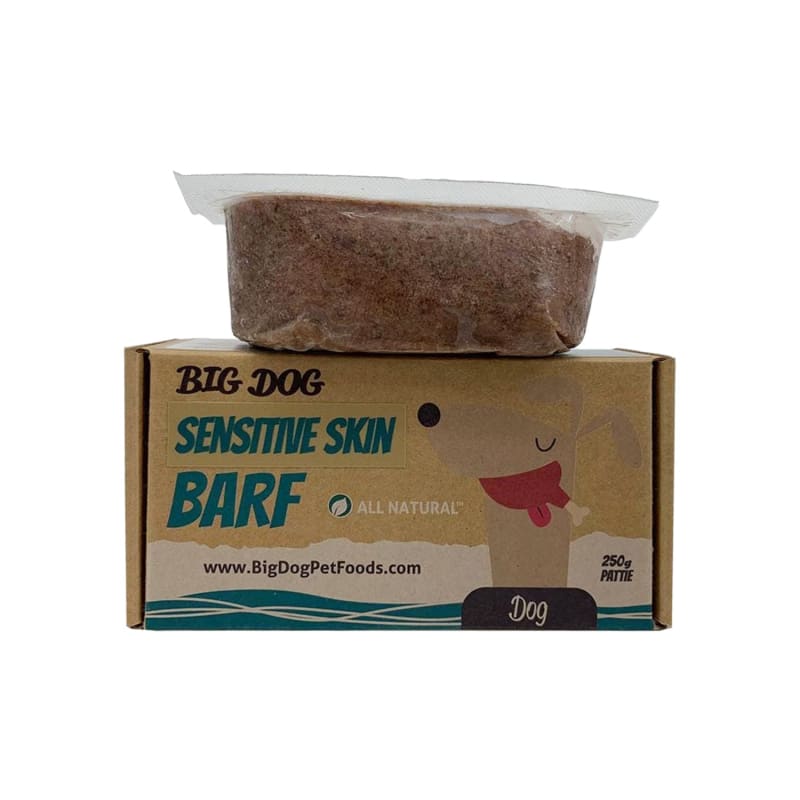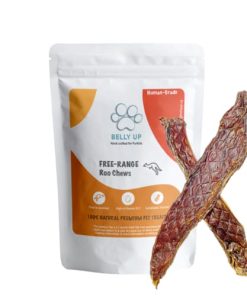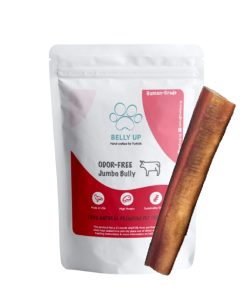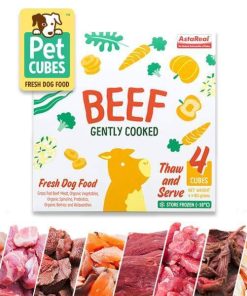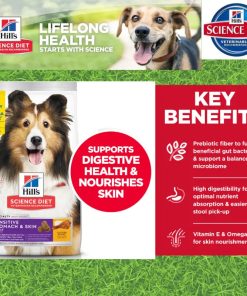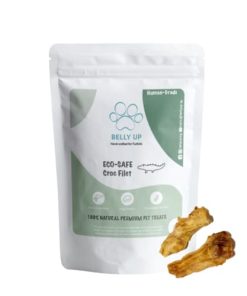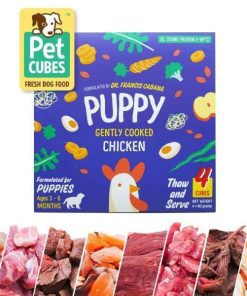Big Dog BARF Sensitive Skin Frozen Raw Dog Food 250g Big Dog
$ 8,24 $ 4,94
Loaded with skin-nourishing and anti-inflammatory goodness, this diet had been formulated to help address skin problems from the inside out and help our dogs get back to their optimal state of health.
Big Dog Sensitive Skin raw food diet contains excellent sources of anti-inflammatory omega-3 fatty acids from whole salmon and sardines. Potent anti-inflammatory ingredients join these in the form of cold-pressed coconut oil, the traditional herb turmeric, and activated chia seeds. These ingredients are responsible for promoting healthy skin, a healthy soft and shiny coat, and a stronger immune system, all working together towards healing and reducing the likelihood of future skin issues.
Of course, to this, Big Dog add nutrient-dense and phytochemical-rich fruits and vegetables. All topped off with Big Dog special extra ingredients, including ginger, garlic, flaxseed, whole eggs, kelp, wheatgrass, probiotics, and prebiotics.
View Big Dog BARF Collection.
Ingredients
Whole fish (salmon & sardines), pork heart, lamb, finely ground lamb cartilage, pork fat, turkey, finely ground turkey bone & cartilage, lamb liver, seasonal fruits, vege & herbs (kale, spinach, broccoli, bok choy, silver beet, carrots, celery, beetroot, lettuce, cucumber, capsicum, apple, orange, pear, tomato, strawberry, ginger & parsley), cold pressed ground flaxseed, fish oil, coconut oil, whole egg, turmeric, activated chia seeds, nettle, herb robert, gotu kola, jiaogulan, alfalfa powder, live probiotics, prebiotics, kelp powder (brown & red seaweed), garlic.
Guaranteed Analysis
Protein 13%,
Fat 11.5%,
Fibre 1.25% Maximum,
Calcium 1.1%,
Phosphorus 0.9%,
Calcium: Phosphorus ratio 1:0.8, Ash 2.4%, Moisture 66%.
Kj/100g = 658 Kj/serve (250g)=1645
Feeding Guide
We recommend feeding adult dogs (12 months +) 2% of their body weight daily. We recommend puppies (generally 12 months and younger), pregnant and lactating dogs or working dogs 4% of their body weight daily. This is based on the nutritional content of our foods.
We recommend feeding adult cats 2-3% of their body weight daily (this is based on an average sized 4kg cat) and kittens 4-6%.
However, our feeding guidelines are a guide and your pets metabolism, breed, size, age and activity level may affect their overall nutritional requirements. Many people wish to replace a raw meal with an appropriate serve of meaty bones for dental health which is an important part of ensuring a healthy raw fed pet. Also taking into account treats as part of the daily energy from food being provided to your pet has an impact.
The important thing to focus on ultimately is that your pet is within a healthy weight range.
It is fine for younger animals (especially puppies) to have extra fat (aka puppy fat) sub 6 months of age. As they grow into adults, its more important to fine tune their diet to suit a healthy weight. A healthy weight can be measured in a number of simple physical ways. Ribs shouldn’t be prominent but should be able to be felt with a thin covering of fat over the top. There should be a visible abdominal tuck and when you look at your pet from above, they should have a visible waist. If the ribs can be seen, increase their daily food allowance, if they no longer have a waist and look like a log from above, decrease their daily food allowance until their waist returns.
Fast Shipping with Professional Packaging
Our long-standing relationship with UPS FedEx DHL and other carriers around the world lets us offer an array of shipping services. Our warehouse personnel are highly skilled and will pack your products according to our exact and precise specifications. Your products will be subjected to an exhaustive examination before they will be securely packaged before being sent out. We ship to thousands clients every day from all over the world. This shows our commitment to be the largest retailer on the internet. These warehouses are situated in Europe as much as they are in the USA.
Note: Orders containing multiple items will have a distinct processing period for each item.
Prior to shipment, all purchased products will be thoroughly inspected. Most orders are now shipped within 48 hrs. Expected delivery times are between 3-7 days.
Returns
The stock is dynamic and we cannot control it completely due to the fact that multiple stakeholders are involved, including our factory and warehouse. The actual stock levels can fluctuate at any time. It is possible that you will not receive your purchase after the order has been made.
Our policy lasts for 30 days. If you haven't received your product within the 30 days period, we're unable to offer the option of a refund or exchange.
In order to be eligible for a return the item must be in good condition and in the same state as you received it. The item must be in the original packaging.
Related products
Dog Food & Treats
3 For $190 Boss Dog Fish Recipe Freeze-dried Dog Food 12oz Boss Dog
Dog Food & Treats
10% OFF Belly Up Roo Chew Air-Dried Dog Treats 70g (Short) Belly Up
Dog Food & Treats
10% OFF Belly Up Duck Wings Air-Dried Dog Treats (2 Sizes) Belly Up
Grooming & Hygiene
Grooming & Hygiene
Grooming & Hygiene
#1 All Systems Ear So Fresh Pet Ear Cleaning Solution 4oz #1 All Systems
Grooming & Hygiene
#1 All Systems Pure White Lightening Pet Shampoo 16oz #1 All Systems
Grooming & Hygiene
#1 All Systems 35mm Pin Wooden Pet Brush (Black Pad) #1 All Systems
Grooming & Hygiene
#1 All Systems Pure Cosmetic Skin & Coat Conditioner 16oz #1 All Systems
Grooming & Hygiene
#1 All Systems Got Hair Action Humectant Moisturising Conditioner Pet Spray 12oz #1 All Systems
Grooming & Hygiene
#1 All Systems Large Pet Pin Brush (4 Colours) #1 All Systems
Grooming & Hygiene
#1 All Systems Color Enhancing Botanical Conditioner 16oz #1 All Systems
Grooming & Hygiene
#1 All Systems Crisp Coat Botanical Texturizing & Detoxifying Dog Shampoo 16oz #1 All Systems
Grooming & Hygiene
#1 All Systems 27mm Pin Wooden Pet Brush (White Pad) #1 All Systems
Grooming & Hygiene
#1 All Systems Got Hair Action Smoothing Serum & Moisturizer Pet Conditioner 16oz #1 All Systems
Dog Food & Treats
15% OFF Belly Up Odour-Free Beef Jumbo Dog Chew 6” 1pc Belly Up
Dog Food & Treats
3% OFF PetCubes Kangaroo Ears Dehydrated Cat & Dog Treats 50g Pet Cubes
Dog Food & Treats
3 For $190 Boss Dog Chicken Recipe Freeze-dried Dog Food 12oz Boss Dog
Dog Food & Treats
Grooming & Hygiene
#1 All Systems Botanical Pet Conditioner 16oz #1 All Systems
Grooming & Hygiene
#1 All Systems Professional Whitening Shampoo 16oz #1 All Systems
Dog Food & Treats
20% Off Science Diet Adult Sensitive Stomach & Skin Dry Dog Food 30lbs Science Diet
Dog Food & Treats
10% OFF Big Dog BARF Combo Frozen Raw Food For Small Dogs 1.5kg Big Dog
Dog Food & Treats
3% OFF PetCubes Beef Liver Dehydrated Cat & Dog Treats 100g Pet Cubes
